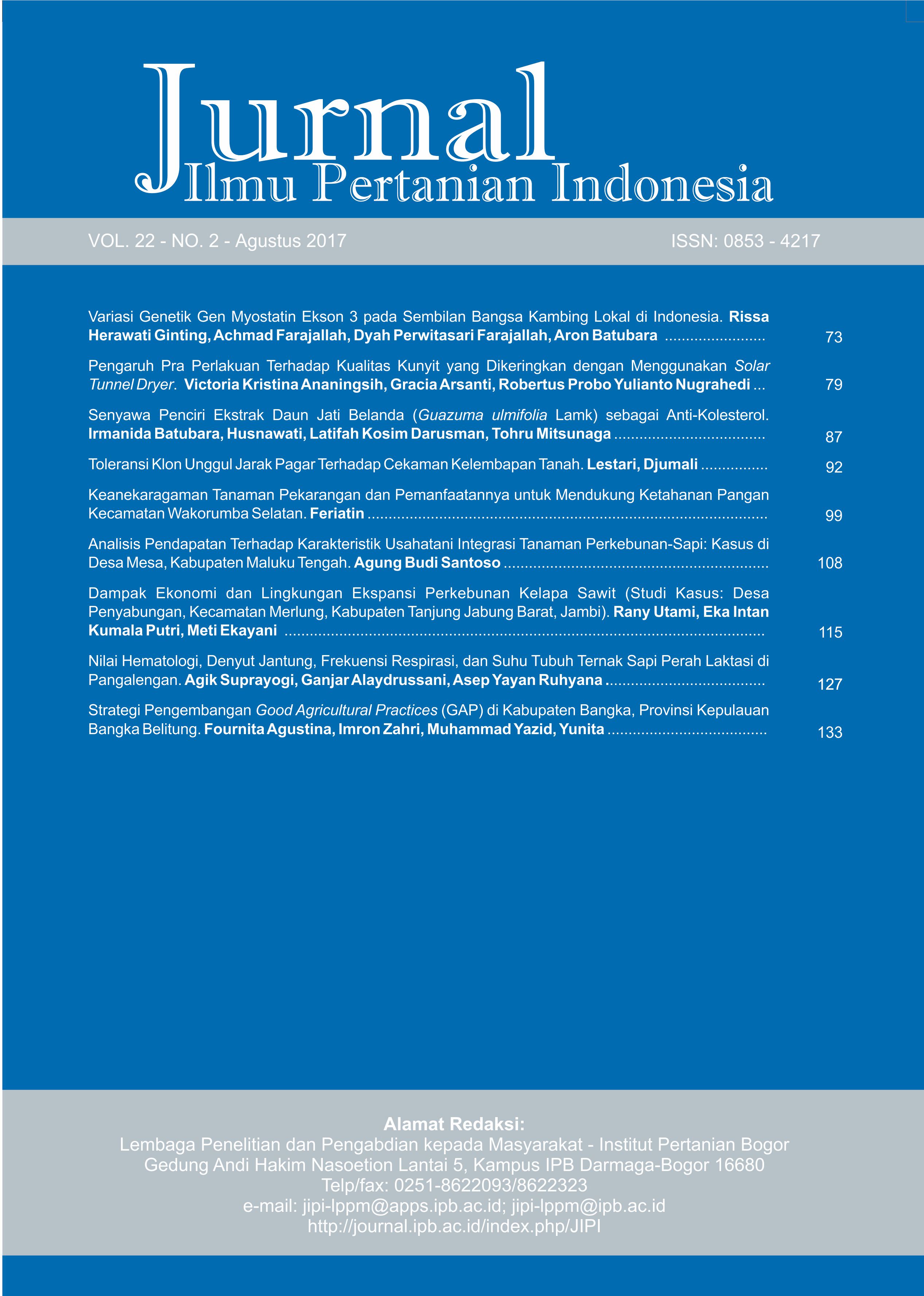Pengaruh Pra Perlakuan Terhadap Kualitas Kunyit yang Dikeringkan dengan Menggunakan Solar Tunnel Dryer
Abstract
Turmeric (Curcuma domestica Val.) has many health benefits and can be used in herbal medicine as well as traditional herbal drink. Turmeric can also be used as a natural dye in food. Turmeric is very perishables in a fresh state, thus drying process is needed to extend its shelf life. An environmentally friendly drying using Solar Tunnel Dryer (STD) is one of the techniques that is interestingly developed. The purpose of this study was to determine the effect of steam blanching at different times (3, 5, and 10 minutes) and soaking using a 0.05% citric acid for 5 minutes on the physicochemical and microbiological qualities of turmeric dried by STD. Measurements were conducted to analyze water content, water activity, curcumin content, antioxidant activity, pH, water activity, color intensity, and total fungi. The results showed that steam blanching and immersion using a 0.05% citric acid for 5 minutes could reduce the drying time when compared to that of control. While 5 minutes of steam blanching with immersion in the 0.05% citric acid for 5 minutes could produce a high antioxidant activity which was 80.30 ± 0.89 (% inhibition) and it had the lowest total fungi which were 3.33 ± 5.00%
Downloads
References
Apriyantono A, Fardiaz D, Puspitasari NL, Sedarnawati, Budiyanto S. 1989. Analisis Pangan. Bogor (ID): IPB Press.
Cahyono B, Huda MDK. 2011. Pengaruh Proses Pengeringan Rimpang Temulawak (Curcuma xanthorriza ROXB ) Terhadap Kandungan dan Komposisi Kurkuminoid. Reaktor. 13(3): 165-171.
Chaudhari AD, Salve PSP. 2014. A Review of Solar Dryer Technologies. International Journal of Research in Advent Technology. 2(2): 218-232.
Darmadi FS, Ananingsih VK. 2008. Studi penerapan teknologi solar tunnel drying pada proses produksi tiwul instan. Jurnal Litbang Provinsi Jawa Tengah. 6(1): 73-88.
Fellows PJ. 2000. Food Processing Technology. Second Edition. Woodhead Publishing Limited Cambridge. England. http://doi.org/c3ff7n
Katno. 2008. Pengelolaan Pasca Panen Tanaman Obat. Balai Besar Penelitian dan Pengembangan Tanaman Obat dan Obat Tradisional. Badan Penelitian dan Pengembangan Kesehatan Departemen Kesehatan RI.
Kurhekar SP, Patil SR, Patil RR. 2015. Studies on quality evaluation of blanched turmeric. International Journal of Processing and Post Harvest Technology. 6(1): 114-117. http://doi.org/b9r6
Lebesi DM, Tzia C. 2011. Effect of the Addition of Different Dietary Fiber and Edible Cereal Bran Sources on the Baking and Sensory Characteristics of Cupcakes. Food and Bioprocess Technology. 4(5): 710-722. http://doi.org/cr58gw
Pangavhane DR, Sawhney RL, Sarsavadia PN. 1999. Effect of various dipping pra perlakuan on drying kinetics of Thompson seedless grapes. Journal of Food Engineering. 39(2): 211-216. http://doi.org/fhjr77
Prathapan A, Lukhman M, Arumughan C, Sundaresan A, Raghu KG. 2009. Effect of heat treatment on curcuminoid, colour value and total polyphenols of fresh turmeric rhizome. Effect of heat treatment on curcuminoid, colour value and total polyphenols of fresh turmeric rhizome. International Journal of Food Science and Technology. 44(7): 1438-1444. http://doi.org/b54dn9
Rukmi I. 2009. Keanekaragaman Aspergillus Pada Berbagai Simplisia Jamu Tradisional. Jurnal Sains Dan Matematika. 17(2): 82-88.
Shinde GU, Kamble KJ, Harkari MG, More GR. 2011. Process Optimization in Turmeric Heat Treatment by Design and Fabrication of Blancher. International Conference on Environmental and Agriculture Engineering. IPCBEE. 15(2011): 36-41.
Singh G, Arora S, Kumar S. 2010. Effect of mechanical drying air conditions on quality of turmeric powder. Journal of Food Science and Technology. 47(3): 347-350. http://doi.org/dx584v
Singleton VL, Rossi JAJr. 1965. Colorimetry of total phenolics with phosphomolybdic-phosphotungstic acid reagents. American Journal of Enology Viticulture. 16: 144-158.
Sudarmadji. 1984. Prosedur Analisis. Analisa Pangan. 1: 39-50.
Suresh D, Manjunatha H, Srinivasan K. 2007. Effect of heat processing of spices on the concentrations of their bioactive principles: Turmeric (Curcuma longa), red pepper (Capsicum annuum) and black pepper (Piper nigrum). Journal of Food Composition and Analysis. 20(3-4): 346-351. http://doi.org/cfb93h
Suresh D, Gurudutt KN, Srinivasan K. 2009. Degradation of bioactive spice compound: Curcumin during domestic cooking. European Food Research and Technology. 228(5): 807-812. http://doi.org/ckqz38
Novia WH, Victoria KA, Probo YN. 2016. The effect of hidrogen peroxyde concentration and immersion time on the quality of ginger (Zingiber officinale Rosc.) dried by Solar Tunnel Dryer. Proceedings 4th International Student Conference. ISBN No. 978-602-6865-26-7, 68-85.
Voragen AGJ, Pilnik W. 2004. Pectin-Degrading Enzymes in Fruit and Vegetable Processing. American Chemical Society Symposium Series. 389(7): 93-115. http://doi.org/fs9xzz
This journal is published under the terms of the Creative Commons Attribution-NonCommercial 4.0 International License. Authors who publish with this journal agree to the following terms: Authors retain copyright and grant the journal right of first publication with the work simultaneously licensed under a Creative Commons Attribution-NonCommercial 4.0 International License. Attribution — You must give appropriate credit, provide a link to the license, and indicate if changes were made. You may do so in any reasonable manner, but not in any way that suggests the licensor endorses you or your use. NonCommercial — You may not use the material for commercial purposes.






















